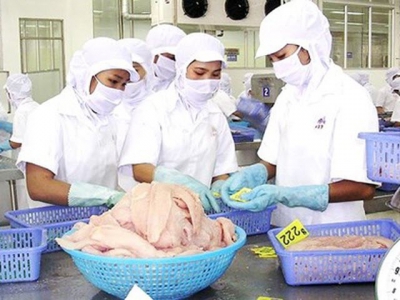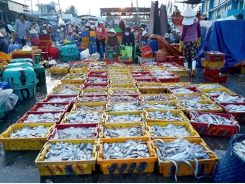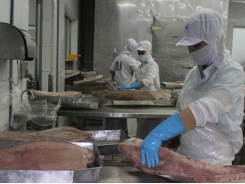Pangasius fish price drops, market fluctuates

After strongly increasing for a long time, the prices of raw pangasius fish in provinces in the Mekong Delta dropped to around VND23,000-VND25,000 per kilogram, at which farmers were only able to break even.
Workers process pangasius fish at a seafood processing company. (Photo: SGGP)
For years, pangasius fish has been raised mainly in An Giang and Dong Thap provinces. According to the People’s Committee of An Giang Province, the farming area of pangasius fish fluctuates around 1,300-1,400 hectares annually with production of around 380,000 – 400,000 tons. Last year, most fish farmers hit the jackpot but since the beginning of this year, the prices of pangasius fish have continuously marched down.
Mr. Le Chi Binh, vice chairman of An Giang Fisheries Association, said that fish farmers have started to sense difficulties returning because last year, pangasius fingerlings were extremely expensive but farmers flocked to raise them, causing input expenses to highly climb; however, the price of commodity pangasius fish currently has fallen drastically, sending fish farmers to the verge of losses or break-evens.
Sharing the same opinion, Mr. Nguyen Thanh Binh, director of Chau Thanh Seafood Production and Service Cooperative in Dong Thap Province, said that fish farmers should not focus on quantity then expanding farming area intensively, especially in the current period, they should tightly control the farming area so as to prevent excessive supply which causes the price to drop further.
Seafood export enterprises in the Mekong Delta said that in recent months, export of pangasius fish has experienced a slump, especially at major markets, including China and the US.
Particularly, pangasius fish exporters exported a worth of US$39.47 million to Hong Kong (China) in March this year, down 12.9 percent over the same period last year. As for the US market, pangasius fish exports also declined by more than 44 percent over the same period last year.
It is more worrisome that the US Department of Commerce recently announced the final result of the 14th administrative review for the period from August 2016 to July 2017 with a relatively high tariff causing disadvantages to Vietnamese enterprises. Amid the aforesaid difficulties, there is a good chance that export of pangasius fish to the US will continue to decline in the near future.
Mr. Doan Toi, CEO of Nam Viet Seafood JSC, said that in the current pangasius fish export structure, the US and China are the two important markets. In 2018 alone, pangasius fish exports into these two markets hit $1 billion. Especially, the price of pangasius fish to the US was fairly high, at $5-$6 per kilogram, doubled that in 2013.
China is a new market for pangasius fish but demand is extremely high. However, this market also contains many risks as its policy is changed constantly. Meanwhile, the US has been imposing high import tariffs on pangasius fish, causing difficulties for promoting export of pangasius fish into this market. Therefore, in order for pangasius fish to be sustainably exported, the industry should diversify export market instead of relying too much on some major markets.
According to Mr. Doan Toi, it is essential for pangasius exporters to revive the EU market as it plays an important role in leading export of pangasius fish. Fortunately, export of pangasius fish to the EU market has also recovered. In February and March this year, pangasius fish exports reached $72 million, up 42 percent compared to the same period last year.
In the ASEAN region, in the first quarter of this year, export of pangasius fish managed to maintain export turnover at above $55 million, up 18 percent over the same period last year. However, exports to potential markets, consisting of UAE, Colombia and Brazil saw a decline in turnover.
Leaders of the National Agro-Forestry-Fisheries Quality Assurance Department warned that technical barriers of several countries in the world have become higher and higher in requirements for quality and food safety.
For instance, China has gradually tightened import of agro-aquatic products through cross border trade and ordered that imported seafood must be produced by firms in the approved list with certificates. The EU warned that if any seafood producer is found using banned antibiotics, it will be removed from the list of firms received permission to export products to the EU.
Meanwhile, Brazil does not allow using additives and request tests on other criteria. At the same time, it will stop importing if there is a shipment violating its regulations. Russia also checks frequently and suspends import of seafood if the enterprise has a shipment that violates its regulations.
Amid the previously mentioned difficulties, firms should quickly change to adapt to the requirements and regulations of each market and comply with standards about food safety besides focusing on expanding export market. Fish farmers should practice farming under VietGAP, GlobalGAP, ASC and BAP standards to provide a clean pangasius fish supply.
Experts said that the industry should not expand farming area but concentrate on connecting fish farmers with seafood producers and increase investment in improving quality as well as create more products to meet diverse demand of the market.
At the same time, it should promote advertising pangasius fish products around the world and have policies to maintain traditional markets as well as open new markets. If solutions are applied synchronously, pangasius fish industry will overcome the current difficult situation and possibly achieve its export target of $2.4 billion this year.
Related news
Tools

Phối trộn thức ăn chăn nuôi

Pha dung dịch thủy canh

Định mức cho tôm ăn

Phối trộn phân bón NPK

Xác định tỷ lệ tôm sống

Chuyển đổi đơn vị phân bón

Xác định công suất sục khí

Chuyển đổi đơn vị tôm

Tính diện tích nhà kính

Tính thể tích ao




 Japan among top 10 importers of Vietnam’s tra…
Japan among top 10 importers of Vietnam’s tra…  Many advantages for tuna exports to ASEAN
Many advantages for tuna exports to ASEAN